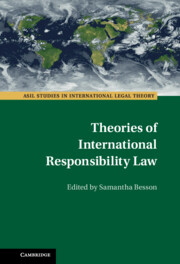Book contents
- Theories of International Responsibility Law
- ASIL Studies in International Legal Theory
- Theories of International Responsibility Law
- Copyright page
- Contents
- Contributors
- Preface
- Theorizing International Responsibility Law, an Introduction
- Part I International Responsibility of Public Institutions: Public and/or Private?
- 1 From ‘Respondere’ to ‘Responsibility’
- 2 Change in the Law of International Responsibility
- 3 State Responsibility
- 4 Responsibility of States for Wrongdoing
- Part II International Responsibility of Public Institutions: Collective and/or Individual?
- Part III International Responsibility of Public Institutions: Fault-based or Not?
- Part IV Responsibility of Public Institutions: A World Tour
- Index
1 - From ‘Respondere’ to ‘Responsibility’
A Roman Lawyer’s Gloss on the International Law of State Responsibility
from Part I - International Responsibility of Public Institutions: Public and/or Private?
Published online by Cambridge University Press: 01 September 2022
- Theories of International Responsibility Law
- ASIL Studies in International Legal Theory
- Theories of International Responsibility Law
- Copyright page
- Contents
- Contributors
- Preface
- Theorizing International Responsibility Law, an Introduction
- Part I International Responsibility of Public Institutions: Public and/or Private?
- 1 From ‘Respondere’ to ‘Responsibility’
- 2 Change in the Law of International Responsibility
- 3 State Responsibility
- 4 Responsibility of States for Wrongdoing
- Part II International Responsibility of Public Institutions: Collective and/or Individual?
- Part III International Responsibility of Public Institutions: Fault-based or Not?
- Part IV Responsibility of Public Institutions: A World Tour
- Index
Summary
This chapter proposes a brief lexical history of the English term ‘responsibility’, starting from the Latin ‘respondere’, through French and Anglo-Norman, up to the emergence of the abstract noun in modern languages. Seen from a purely semantic diachronic perspective, ‘responsibility’, as a legal term, expresses the idea that one may be called upon to answer for one’s activity (or inactivity) but does not itself denote the prerequisites of liability nor hints at the source or nature of any duty to do so. It looks at what is to be done in the future, not to the imputation of a duty by reference to what has gone before. If the meaning that history brings to light is quite neutral – and pivots around the ordinary, basic meaning of the verb ‘respondere’: ‘to say something in answer to a question’ – ‘responsibility’ appears nonetheless to be most appropriate to signify the distinctive feature of contemporary international law, namely that States ‘have to answer’ for their actions.
- Type
- Chapter
- Information
- Theories of International Responsibility Law , pp. 27 - 42Publisher: Cambridge University PressPrint publication year: 2022

